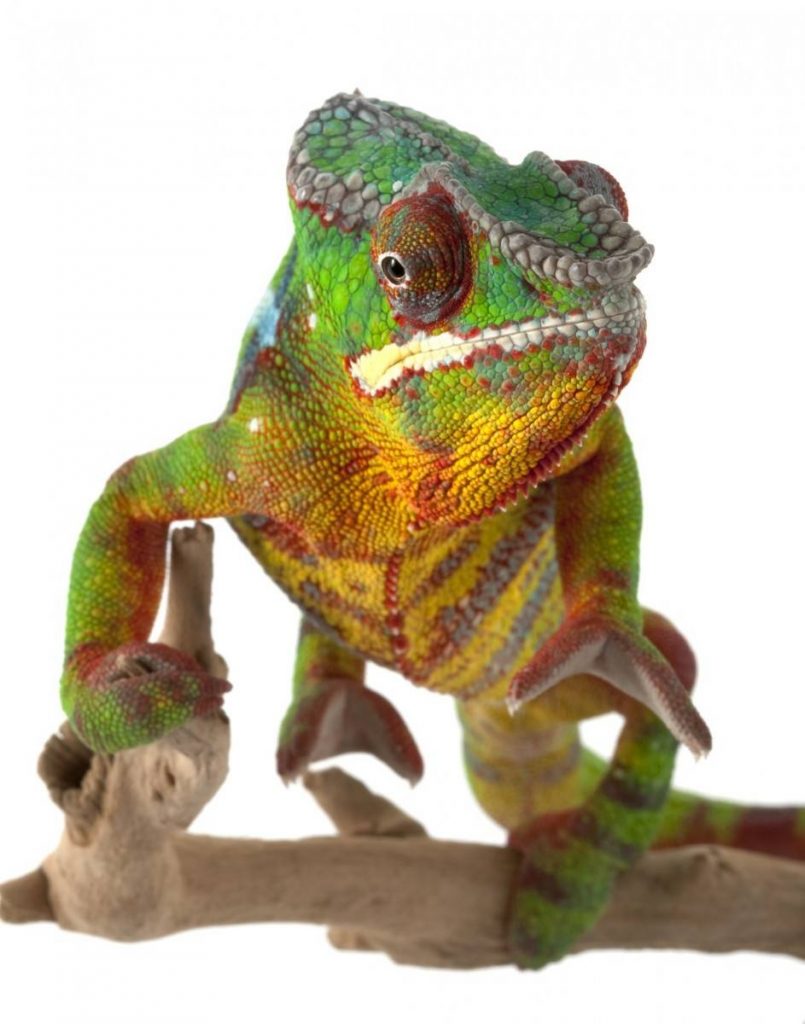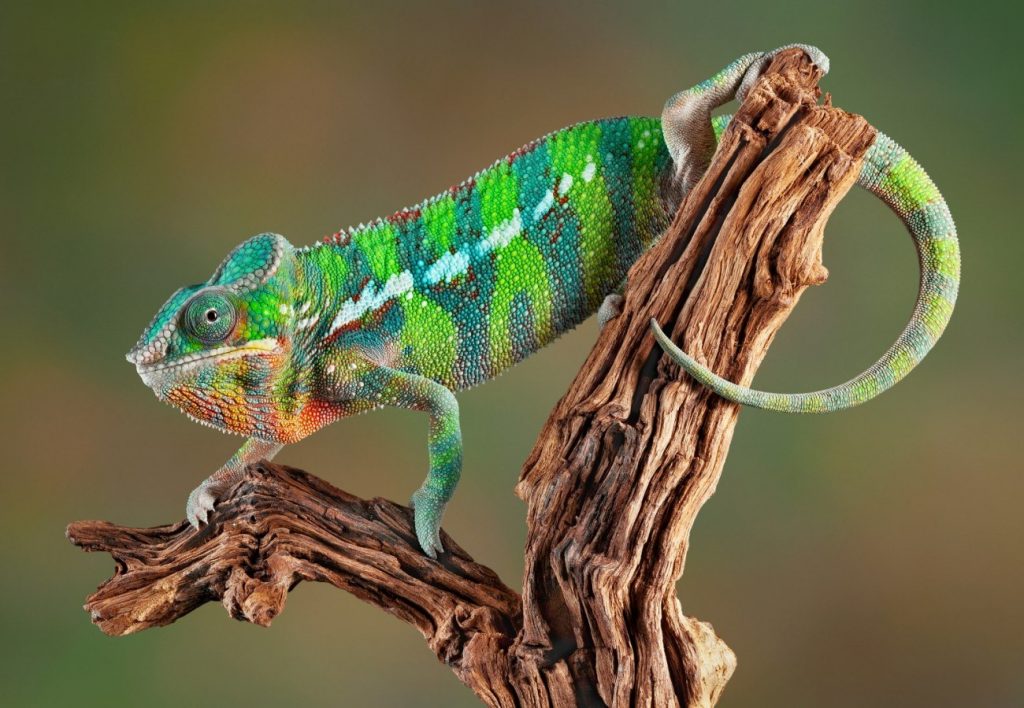PANTHER CHAMELEON
(Furcifer pardalis)
FOR THE MONTH OF FEBRUARY, GET A PAIR OF BABY AMBILOBES FOR JUST $249.99, WHILE SUPPLIES LAST.
We are lucky to be able to work with an incredible variety of different animals here at Scales ‘N Tails, and we find beauty in each and every one of them. For some species, the beauty is found in the personality, for others it lies in unique behaviors, and some of them are just beautifully bizarre. We understand that not everyone would agree that a snake is a beautiful animal, and even fewer would apply the term to a tarantula. There are however, a few of our animals whose beauty is undeniable, no matter who you ask, and this month’s featured animal sits atop that list. So, without further ado, we are excited to announce that the stunning Panther Chameleon (Furcifer pardalis,) is our Animal of the Month for February 2018!
Panther Chameleons are without a doubt one of the most gorgeous creatures on the planet, and their availability in the pet market makes them a very popular choice for reptile keepers. Native only to the costal lowlands of the small island of Madagascar, this species is incredibly isolated in the wild. (Luckily, it is very commonly bred in captivity.) Like most chameleons, this is an arboreal animal, perfectly designed for living amongst the trees in its native tropical forest habitat. They have incredibly powerful feet that allow them to cling tightly to vines and branches. At first appearance they would seem to have only 2 toes per foot, however, their toes are actually fused together, into a set of 3 toes on the inside of each foot and 2 toes on the outside. This is made evident by the fact that each toe, even though fused to another, has its own claw, so that each foot a total of 5 claws.
As a sexually dimorphic species, male Panthers exhibit a more brilliant coloration than do females, and that color is certainly their most notable characteristic. There is actually striking variation in their coloration depending on the specific region, or locale, individuals are found. Panther Chameleons from the areas of Ambilobe and Sambava are bright green and/or red, while those from Nosy Be and Ambanja are typically a vivid blue.
While their care requirements are not necessarily for beginner keepers, Scales ‘N Tails still highly recommends Panther Chameleons. We believe they make wonderful pets for anyone willing to commit to providing them with the appropriate care. With an average adult length of about 15-20 inches, they’re a relatively large chameleon, which means adults will require a large terrarium to be comfortable. They are very hardy in captivity when kept properly and are not typically aggressive in nature. They are not, however, animals that enjoy being handled often, and prefer to keep to themselves.
CARING FOR A PET PANTHER CHAMELEON
Caring for a pet Panther Chameleon properly involves creating the right environment, and then maintaining it so that temperatures and humidity levels are appropriate and consistent. This may be slightly more time consuming and costly than it would be for other lizards, but it is straight-forward and relatively simple. For most situations, we recommend starting babies off in small, tall terrariums, and upgrading to large, tall terrariums before they reach their mature adult size. Zoo Med’s 12”x12”x18” Naturalist Terrarium or ReptiBreeze Terrarium are both ideal for young panthers, with adults requiring something about twice that size. (Airflow is important for Panther Chameleons, so the screen cage options are ideal, provided the right temperature and humidity can be achieved when using one.)
Panther Chameleons will likely never journey down to the cage floor, so bedding isn’t essential, but we recommend it. We like Zoo Med’s Eco Earth and ReptiSoil substrates, filled to a depth of about 2 inches, as both are excellent at holding moisture and increasing humidity. A choice piece or two of cork bark or sandblasted grapevine should be placed vertically to provide plenty of climbing area and hide spots. Artificial or live plants are also important elements in a well put together Panther Chameleon cage. These plants will beautify the terrarium for the owner, while also providing the chameleon with a greater feeling of comfort and security. Growing live plants inside a terrarium is easy, as many different plant species grow very well in the tropical environment that was created for the animal.
Captive Panther Chameleons will require supplemental sources of heat and UVB light to substitute for what the sun would provide naturally. The ambient cage temperature should be kept at approximately 75°F, with a basking hot spot around 85°F. In addition, they must be provided with a full spectrum UVB lighting source. UVB is critical to their health as it aids in their bodies synthesizing Vitamin D3 and properly absorbing the calcium in their diet. A bulb with mid-range output is ideal, and we recommend the Zoo Med 5.0 linear and compact fluorescent bulbs for all chameleon species.
Humidity is also very important, and panthers require levels in the range of 50% – 70% for optimum wellness. Increasing relative humidity can be easily accomplished by misting the cage two or three times per day with a spray bottle and keeping a dripper system running during daytime hours. We also recommend the Zoo Med ReptiFogger for all humidity loving animals as it is very easy to use and relieves the owner of the responsibility of daily misting. Panther Chameleons will most typically drink from the small water droplets that accumulate on the sides of the terrarium and the plant leaves after a good misting, but we do still recommend keeping a small water dish, with clean water available at all times. Understand that providing a pet chameleon with the proper environment is crucial to its health. We strongly recommend using a Thermometer & Humidity Gauge to ensure conditions are right as it is very hard to guess these things with much accuracy.
Once it’s environmental needs have been met, simply provide your chameleon a few appropriately sized Dubia Roaches or Crickets every other day and you’ll have a happy, healthy pet. It is actually very entertaining to watch chameleons hunt insects down. Panther Chameleons use their very long, sticky tongues to catch prey from a distance. They are capable of rapidly extending their tongues towards an unsuspecting insect to a distance nearly equal to their body length! When their tongue’s bulbous tip makes contact with the insect it sticks right to it, thanks to a thin layer of mucus, enabling it to quickly pull its prey right into its mouth!
In general, chameleons are not long living animals, but if you provide the right environment for your Panther Chameleon, you’ll be able to enjoy your pet for a good while. Captive animals can easily live 5+ years under the proper conditions, with males typically enjoying a few more years than females.

Finally, we wouldn’t be doing our Animal of the Month justice if we didn’t make it an affordable pet option. So, for the month of February, while supplies last, we will have well-started pairs of baby Ambilobe Panther Chameleons, captive breed right here in Colorado, available for $249.99! (That’s less than the price one would typically pay for a single baby male!) So, if you’re interested in a pair of beautiful new pet chameleons, this is a great time to get one!

